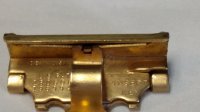I've seen Schick Injectors while visiting antiques stores and, out of curiosity, have been reading up on them. I have been thinking of picking up a Type E or G but according to Schick Injector Razors, only the E1 and some E2 were allowed to be opened for cleaning. Later type E2-E5 and G had tabs or restraints that fixed the spring in place.
Looking on the 'Bay, it seems many of the later model Type E and G with tabs or restraints have been "forced" open; the spring wasn't supposed to be rotated but the user apparently decided otherwise.
Sometimes the scratch where the spring was pivoted is very faint but it's there:

I've read that forcing open these later models could damage the razor by weakening the spring to where it wouldn't hold the blade properly.
So, should I avoid these Type E and G that have been forced open and only look at buying ones that doesn't show any evidence of the spring being rotated? Or am I being overly cautious?
Looking on the 'Bay, it seems many of the later model Type E and G with tabs or restraints have been "forced" open; the spring wasn't supposed to be rotated but the user apparently decided otherwise.
Sometimes the scratch where the spring was pivoted is very faint but it's there:

I've read that forcing open these later models could damage the razor by weakening the spring to where it wouldn't hold the blade properly.
So, should I avoid these Type E and G that have been forced open and only look at buying ones that doesn't show any evidence of the spring being rotated? Or am I being overly cautious?